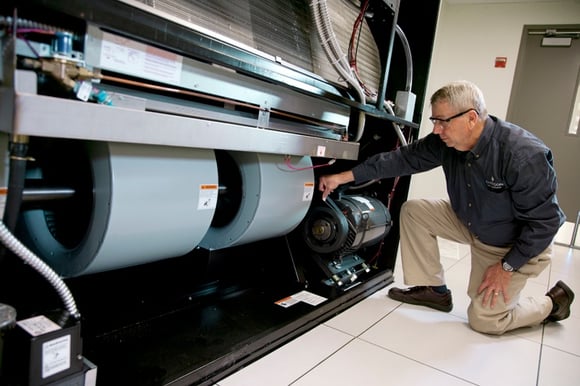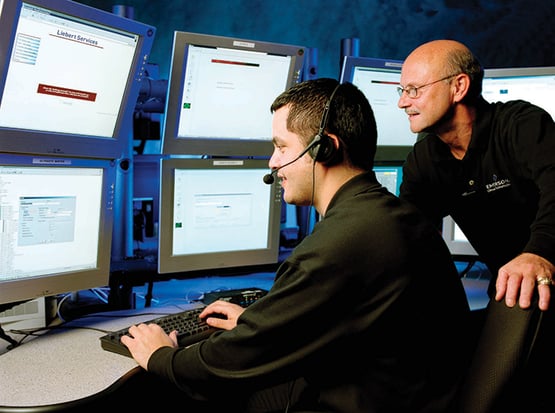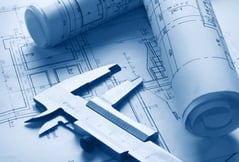Critical Environments: Power, Cooling, and Infrastructure
For HVAC Emergencies: 1-866-DVL-HVAC | For UPS Emergencies: 1-800-LIEBERT
For Generator Emergencies in CO, NM, or WY:303-953-3128
For HVAC Emergencies, please call 1-866-DVL-HVAC
For HVAC Emergencies: 1-866-DVL-HVAC | For UPS Emergencies: 1-800-LIEBERT
For Generator Emergencies in CO, NM, or WY:303-953-3128
For HVAC Emergencies, please call 1-866-DVL-HVAC
by Marissa Donatone on 7/22/15 10:27 AM
Topics: Data Center, energy, service, HVAC, Uptime, Power and Cooling, 7x24
by Emerson Network Power on 7/15/15 3:23 PM

Fans that move air and pressurize the data center’s raised floor are significant components of cooling system energy use. After mechanical cooling, fans are the next largest energy consumer on computer room air condition (CRAC) units. One way many data center managers reduce energy usage and control their costs is by investing in variable speed fan technology. Such improvements can save fan energy consumption by as much as 76 percent.
With the different options on the market, it may not be clear which technology is best. Today, variable speed drives (VSDs)—also referred to as variable frequency drives or VFDs—and electrically commutated (EC) fansare two of the most effective fan improvement technologies available. The advantages of both options are outlined below to help data center managers determine which fan technology is best for achieving energy efficiency goals.
How do different fan technologies work?
In general, variable speed fan technologies save energy by enabling cooling systems to adjust fan speed to meet the changing demand, which allows them to operate more efficiently. While cooling units are typically sized for peak demand, peak demand conditions are rare in most applications. VSDs and EC fans more effectively match airflow output with load requirements, adjusting speeds based on changing needs. This prevents overcooling and generates significant energy savings.
With VSDs, drives are added to the fixed speed motors that propel the centrifugal fans traditionally used in precision cooling units. The drives enable fan speed to be adjusted based on operating conditions, reducing fan speed and power draw as load decreases. Energy consumption changes dramatically as fan speed is decreased or increased due to the fan laws. For this reason, a 20 percent reduction in fan speed provides nearly 50 percent savings in fan power consumption.
EC fans are direct drive fans that are integrated into the cooling unit by replacing the centrifugal fans and motor assemblies. They are inherently more efficient than traditional centrifugal fans because of their unique design, which uses a brushless EC motor in a backward curved motorized impeller. EC fans achieve speed control by varying the DC voltage delivered to the fan. Independent testing of EC fan energy consumption versus VSDs found that EC fans mounted inside the cooling unit created an 18 percent savings. With new units, EC fans can be located under the floor, further increasing the savings.
How do VSDs and EC fans compare?
Energy Savings
One of the main differences between VSDs and EC fans is that VSDs save energy when the fan speed can be operated below full speed. VSDs do not reduce energy consumption when the airflow demands require the fans to operate at or near peak load. Conversely, EC fans typically require less energy even when the same quantity of air is flowing. This allows them to still save energy when the cooling unit is at full load. EC fans also distribute air more evenly under the floor, resulting in more balanced air distribution. Another benefit of direct-drive EC fans is the elimination of belt losses seen with centrifugal blowers. Ultimately, EC fans are the more efficient fan technology.
Cooling Unit Type
VSDs are particularly well-suited for larger systems with ducted upflow cooling units that require higher static pressures, while EC fans are better suited for downflow units.
Maintenance
In terms of maintenance, EC fans offer an advantage. EC fans also reduce maintenance because they have no fan belts that wear and their integrated motors virtually eliminate fan dust.
Installation
Both VSDs and EC fans can be installed on existing cooling units or specified in new units. When installing on existing units, factory-grade installation is a must.
Payback
In many cases, the choice between VSDs and EC fans comes down to payback. If rapid payback is a priority, then VSDs are likely the better choice. These devices can offer payback in fewer than 10 months when operated at 75 percent.
However, EC fans will deliver greater, long-term energy savings and a better return on investment (ROI). While EC fans can cost up to 50 percent more than VSDs, they generate greater energy savings and reduce overall maintenance costs, ultimately resulting in the lowest total cost of ownership.
Have the experts weigh in.
Service professionals can be an asset in helping choose the best fan technology for a data center. Service professionals can calculate the ROI from both options, and they can recommend the best fan technologies for specific equipment.
Service professionals trained in optimizing precision cooling system performance can also ensure factory-grade installations, complete set point adjustment to meet room requirements, and properly maintain equipment, helping businesses achieve maximum cooling unit efficiency today and in the future.
Whether you ultimately decide to go with VSDs or EC fans, either way, you’ll be rewarded with a greener data center, more efficient cooling, and significant energy savings that translate into a better bottom line.
Topics: data center energy, PUE, Battery, Efficiency, Thermal Management, DCIM, Uptime, the green grid, AHRI, availability, education, KVM, Data Center efficiency, preventative maintenance
by Emerson Network Power on 7/1/15 11:20 AM

IT managers and facility managers make promises to their businesses and their customers to maintain critical system availability. One key way they can keep their word and deliver on those promises is by properly monitoring and maintaining the batteries that back up the UPS. After all, a UPS is only as reliable as the batteries that support it, and all too often, battery failure is the cause of unplanned, costly downtime in data centers.
Monitoring alone may not be enough.
Maintaining and continuously monitoring critical battery parameters to detect early signs of battery degradation can go a long way toward reducing battery failure and thus preventing downtime. However, evidence suggests that stationary battery monitoring and data collection might not be enough.
In our 2007 white paper, “The Effect of Regular, Skilled Preventive Maintenance and Remote Monitoring on Critical Power System Reliability,” Emerson Network Power demonstrated that while data centers with on-site battery monitoring systems had a reduced rate of outages due to bad batteries, outages did still happen. Such outages occur when customers do not properly monitor the system, or when they do not know how to properly analyze the data provided by the monitor. Simply put, having the right information, and knowing what to do with it, are two very different things.
Remote monitoring ensures added protection.
Monitoring that enables remote services is a solution to address these issues. Remote services allow a third party service partner—preferably a partner with full knowledge of critical infrastructure and battery maintenance best practices—to monitor data collected by battery monitoring technology and properly maintain the system based on the data analysis.
The latest technologies, as seen with Albér battery monitoring solutions, monitor parameters such as cell voltage, overall string voltage, current, and temperature. The technology also enables automatic periodic tests of the battery’s internal resistance. Such monitoring and testing verifies the operating integrity of the battery and identifies potential problems early on.
When this technology is supplemented with remote services, skilled battery experts support battery monitoring efforts around the clock. When the monitoring technology detects issues, the remote service technicians receive alerts. They can then put into action a pre-defined escalation plan to address the alarm. As a result, the appropriate steps are taken to correct minor battery problems before they evolve into major system issues, thus protecting other batteries in the string, preventing major system damage, and improving overall system availability.
As an added benefit, remote service providers can analyze the comprehensive data collected by a battery monitoring system and provide data center managers with essential information for making battery maintenance and replacement decisions.
Outside help can improve performance within.
A battery monitoring solution that enables remote services allows data center managers to augment their staffs with around-the-clock, expert support for maintaining battery health and preventing costly downtime. This allows IT and facility staff to focus on more strategic data center infrastructure management initiatives that support core business objectives. Ultimately, battery monitoring with remote services allows IT and facility managers to do their jobs more effectively, dramatically reduce downtime risks, and ensure system availability for the businesses and the customers they serve.
Topics: data center infrastructure, Data Center, 7x24 exchange, Battery, Uptime, monitoring, the green grid, availability, batteries
by Marissa Donatone on 5/25/15 10:59 AM

Thank you to all who served in our Armed Forces. We observe this day to honor you and your families.
by Marissa Donatone on 5/22/15 1:39 PM
 Make sure to catch Emerson Network Power's Critical Advantage Webcast Series on Tuesday, June 9, at 1 p.m. ET
Make sure to catch Emerson Network Power's Critical Advantage Webcast Series on Tuesday, June 9, at 1 p.m. ET
The New Era of Thermal Controls: See Where They Can Take Your Data Center
Thermal systems account for 38% of data center energy usage. A new generation of thermal system controls can help you reduce it.
Find out how by attending our Emerson Critical Advantage Webcast on May 18 – where we introduce the industry’s latest innovation in thermal system controls: the all-new Liebert® iCOM™ controls.
During our webcast, you’ll see how this new technology can:
Topics: Emerson Network Power, Data Center, energy, Energy Star, Thermal Management, energy efficiency, webcast, performance, iCom
Philadelphia | Albuquerque | Boise | Denver | Harrisburg | Salt Lake City
Headquarters: 115 Sinclair Rd., Bristol, PA 19007
1-215-785-5950